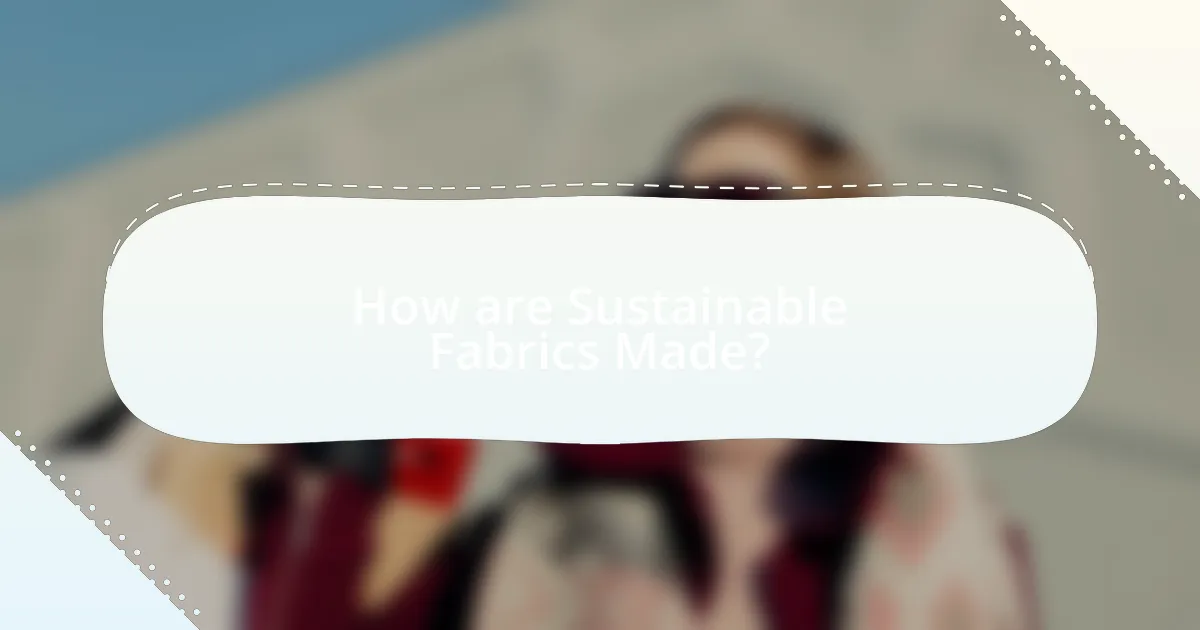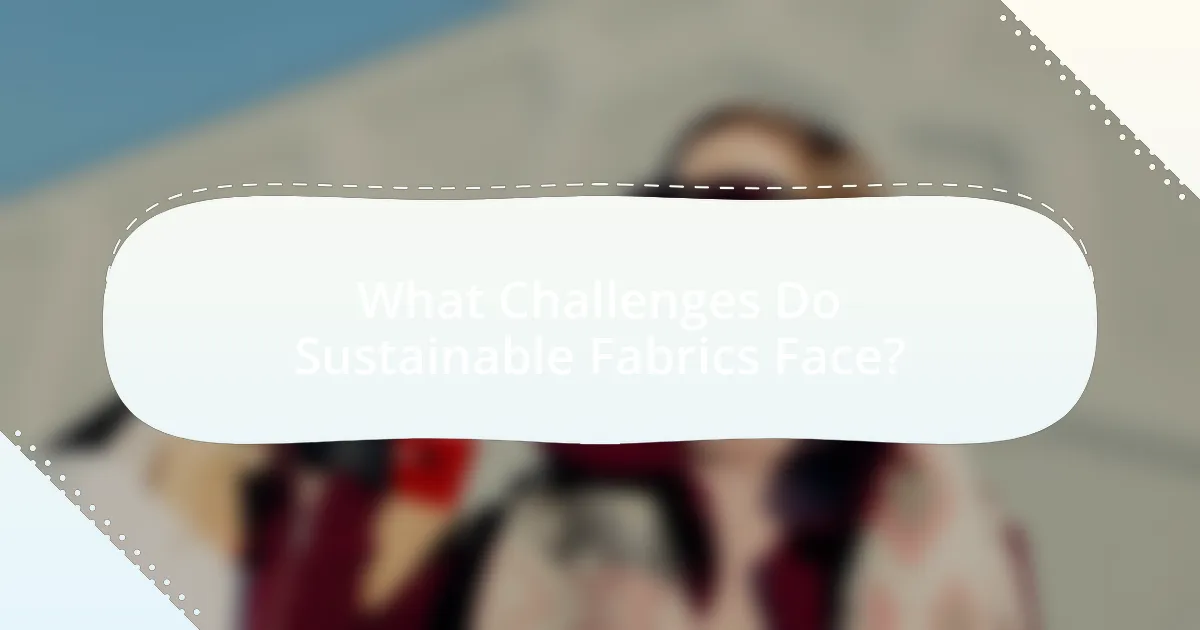Sustainable fabrics are materials produced through environmentally friendly methods that minimize harm to ecosystems and human health. This article explores the definition, criteria, and importance of sustainable fabrics in the fashion industry, highlighting their differences from conventional fabrics and the environmental impacts of traditional textile production. It also examines the manufacturing processes, innovations, and challenges faced by sustainable fabrics, including cost factors and consumer perceptions. Additionally, the article discusses strategies for promoting sustainable fabrics and best practices for their incorporation into fashion design, emphasizing the role of education and awareness in enhancing consumer acceptance.

What are Sustainable Fabrics?
Sustainable fabrics are materials produced in environmentally friendly ways, minimizing harm to ecosystems and human health. These fabrics often come from renewable resources, such as organic cotton, hemp, or recycled materials, and are manufactured using processes that reduce water consumption, chemical usage, and carbon emissions. For example, organic cotton is grown without synthetic pesticides and fertilizers, which helps preserve soil health and biodiversity. Additionally, fabrics made from recycled plastics, like rPET, divert waste from landfills and reduce the need for virgin materials, thus lowering environmental impact.
How are sustainable fabrics defined in the fashion industry?
Sustainable fabrics in the fashion industry are defined as materials that are produced with minimal environmental impact and are often made from renewable resources. These fabrics prioritize eco-friendly practices throughout their lifecycle, including sourcing, production, and disposal. For instance, organic cotton and Tencel are examples of sustainable fabrics that reduce chemical use and water consumption during cultivation and manufacturing. The Global Organic Textile Standard (GOTS) certifies textiles made from organic fibers, ensuring they meet strict environmental and social criteria, which reinforces the definition of sustainable fabrics in the industry.
What criteria classify a fabric as sustainable?
A fabric is classified as sustainable based on criteria such as the use of renewable resources, low environmental impact during production, and the ability to be recycled or biodegraded. Sustainable fabrics often originate from organic materials, which are grown without harmful pesticides or synthetic fertilizers, thereby reducing soil and water pollution. Additionally, the manufacturing processes for sustainable fabrics typically consume less energy and water compared to conventional methods. For instance, organic cotton uses 91% less water than conventional cotton, according to the World Wildlife Fund. Furthermore, sustainable fabrics should also prioritize fair labor practices, ensuring that workers are treated ethically and compensated fairly.
How do sustainable fabrics differ from conventional fabrics?
Sustainable fabrics differ from conventional fabrics primarily in their environmental impact and production processes. Sustainable fabrics are made from renewable resources, such as organic cotton or recycled materials, which reduce waste and pollution. In contrast, conventional fabrics often rely on non-renewable resources like petroleum-based fibers and involve chemical-intensive processes that contribute to environmental degradation. For instance, the production of conventional polyester emits significant greenhouse gases, while sustainable alternatives like Tencel are produced using a closed-loop process that recycles water and solvents, minimizing waste.
Why is the use of sustainable fabrics important?
The use of sustainable fabrics is important because they significantly reduce environmental impact and promote ethical practices in the fashion industry. Sustainable fabrics, such as organic cotton, hemp, and recycled polyester, require less water and energy to produce compared to conventional materials, thereby minimizing resource depletion. For instance, organic cotton uses 91% less water than traditional cotton farming, according to the Textile Exchange. Additionally, sustainable fabrics often involve less harmful chemicals, reducing pollution and promoting healthier ecosystems. By choosing sustainable fabrics, consumers support a circular economy that prioritizes environmental stewardship and social responsibility, ultimately contributing to a more sustainable future in fashion.
What environmental impacts do traditional fabrics have?
Traditional fabrics have significant environmental impacts, primarily due to resource-intensive production processes. The cultivation of natural fibers like cotton requires large amounts of water and pesticides, contributing to water scarcity and soil degradation. For instance, it takes approximately 7,000 liters of water to produce just one kilogram of cotton, highlighting the strain on freshwater resources. Additionally, synthetic fabrics, derived from petroleum, contribute to fossil fuel depletion and generate microplastics that pollute oceans and harm marine life. The dyeing and finishing processes of both natural and synthetic fabrics often involve toxic chemicals, leading to water pollution and adverse health effects for communities near manufacturing sites. These factors collectively underscore the environmental challenges associated with traditional fabric production.
How do sustainable fabrics contribute to reducing carbon footprints?
Sustainable fabrics contribute to reducing carbon footprints by utilizing eco-friendly materials and production processes that minimize greenhouse gas emissions. For instance, organic cotton, which is grown without synthetic pesticides and fertilizers, requires less energy and water compared to conventional cotton, resulting in a lower carbon output. Additionally, fabrics made from recycled materials, such as recycled polyester, divert waste from landfills and reduce the need for virgin resources, further decreasing carbon emissions associated with manufacturing. Studies indicate that using recycled polyester can save up to 75% of the energy required to produce new polyester, significantly lowering the overall carbon footprint of textile production.
What types of sustainable fabrics are available?
Sustainable fabrics include organic cotton, hemp, Tencel (lyocell), recycled polyester, and bamboo. Organic cotton is grown without synthetic pesticides or fertilizers, reducing environmental impact. Hemp requires minimal water and no pesticides, making it a highly sustainable option. Tencel, made from sustainably sourced wood pulp, is produced in a closed-loop process that recycles water and solvents. Recycled polyester is created from post-consumer plastic bottles, diverting waste from landfills. Bamboo grows rapidly and requires little water, but its sustainability depends on processing methods. These fabrics contribute to eco-friendly fashion by minimizing resource use and waste.
What are the most common natural sustainable fabrics?
The most common natural sustainable fabrics include organic cotton, linen, hemp, Tencel (lyocell), and bamboo. Organic cotton is grown without synthetic pesticides or fertilizers, making it environmentally friendly. Linen, derived from the flax plant, requires less water and pesticides compared to conventional cotton. Hemp is known for its low environmental impact, as it grows quickly and requires minimal resources. Tencel, made from sustainably sourced wood pulp, is produced in a closed-loop process that recycles water and solvents. Bamboo is a fast-growing plant that can be cultivated without harmful chemicals, although its processing can vary in sustainability. These fabrics are increasingly favored in eco-friendly fashion due to their reduced environmental footprint and biodegradability.
How do synthetic sustainable fabrics compare to natural ones?
Synthetic sustainable fabrics generally offer advantages in durability and versatility compared to natural fabrics. For instance, synthetic fabrics like recycled polyester can be engineered to be more resistant to wear and tear, while also allowing for a wider range of design possibilities. In contrast, natural fabrics such as cotton or wool are biodegradable and often perceived as more environmentally friendly due to their renewable sources. However, the production of natural fabrics can involve significant water usage and pesticide application, which can negate some of their sustainability benefits. Studies indicate that recycled synthetic fabrics can reduce waste and lower carbon footprints when compared to traditional natural fibers, making them a viable option in eco-friendly fashion.

How are Sustainable Fabrics Made?
Sustainable fabrics are made using eco-friendly materials and processes that minimize environmental impact. These fabrics often originate from renewable resources such as organic cotton, hemp, or recycled polyester, which reduce reliance on petroleum-based fibers. The production methods typically involve less water, fewer chemicals, and lower energy consumption compared to conventional fabric manufacturing. For instance, organic cotton is grown without synthetic pesticides or fertilizers, and recycled polyester is produced from post-consumer plastic bottles, diverting waste from landfills. This approach not only conserves resources but also promotes a circular economy in the textile industry.
What processes are involved in creating sustainable fabrics?
Creating sustainable fabrics involves several key processes, including sourcing eco-friendly materials, utilizing low-impact manufacturing techniques, and implementing responsible waste management practices. Sourcing eco-friendly materials often includes using organic fibers, recycled materials, or innovative alternatives like Tencel, which is derived from sustainably harvested wood pulp. Low-impact manufacturing techniques focus on reducing water and energy consumption, as well as minimizing harmful chemical usage during production. Responsible waste management practices involve recycling fabric scraps and utilizing closed-loop systems to ensure that waste is minimized and materials are reused. These processes collectively contribute to the overall sustainability of fabric production, aligning with the growing demand for eco-friendly fashion solutions.
How does sourcing raw materials impact sustainability?
Sourcing raw materials significantly impacts sustainability by determining the environmental footprint of production processes. The extraction and processing of raw materials can lead to habitat destruction, pollution, and depletion of natural resources, which directly affects ecosystems and biodiversity. For instance, the fashion industry heavily relies on cotton, which requires substantial water and pesticide use, contributing to water scarcity and soil degradation. According to the World Wildlife Fund, conventional cotton farming uses about 2.6% of the world’s arable land but accounts for 24% of global insecticide use. Sustainable sourcing practices, such as using organic or recycled materials, can mitigate these negative effects by reducing chemical inputs and conserving resources, thereby promoting a more sustainable production cycle.
What manufacturing techniques enhance the sustainability of fabrics?
Manufacturing techniques that enhance the sustainability of fabrics include organic fiber cultivation, waterless dyeing processes, and the use of recycled materials. Organic fiber cultivation reduces the reliance on synthetic pesticides and fertilizers, promoting healthier ecosystems. Waterless dyeing processes, such as digital printing and supercritical CO2 dyeing, significantly decrease water consumption and pollution associated with traditional dyeing methods. The incorporation of recycled materials, such as post-consumer plastics or textile waste, minimizes resource extraction and landfill contributions, thereby reducing the overall environmental impact of fabric production. These techniques collectively contribute to a more sustainable fabric manufacturing industry.
What innovations are driving sustainable fabric production?
Innovations driving sustainable fabric production include the development of bio-based materials, recycling technologies, and waterless dyeing processes. Bio-based materials, such as those derived from agricultural waste or algae, reduce reliance on petroleum-based fibers and lower carbon footprints. Recycling technologies, like closed-loop systems, enable the transformation of post-consumer textiles into new fabrics, significantly minimizing waste. Waterless dyeing processes, such as digital printing and supercritical CO2 dyeing, drastically reduce water consumption and pollution associated with traditional dyeing methods. These advancements collectively contribute to a more sustainable textile industry by addressing environmental concerns and resource efficiency.
How is technology influencing the development of sustainable fabrics?
Technology is significantly influencing the development of sustainable fabrics by enabling innovative materials and production processes that reduce environmental impact. Advanced techniques such as 3D knitting and digital printing minimize waste by allowing for precise fabric creation, while innovations in fiber technology, like the development of bio-based and recycled fibers, contribute to resource conservation. For instance, companies like Adidas have introduced shoes made from ocean plastic, demonstrating how technology can repurpose waste into functional products. Additionally, the use of blockchain technology in supply chains enhances transparency, allowing consumers to verify the sustainability of the fabrics they purchase. These technological advancements collectively drive the fashion industry towards more sustainable practices.
What role do certifications play in sustainable fabric production?
Certifications play a crucial role in sustainable fabric production by providing verified standards that ensure environmental and social responsibility in the manufacturing process. These certifications, such as Global Organic Textile Standard (GOTS) and OEKO-TEX, establish criteria for organic materials, chemical usage, and labor practices, thereby promoting transparency and accountability in the textile industry. For instance, GOTS requires that at least 70% of the fibers in a product be organic, ensuring that sustainable practices are upheld throughout the supply chain. This verification helps consumers make informed choices and encourages manufacturers to adopt eco-friendly practices, ultimately contributing to a more sustainable fashion industry.

What Challenges Do Sustainable Fabrics Face?
Sustainable fabrics face several challenges, including higher production costs, limited availability of raw materials, and consumer awareness. Higher production costs arise from the use of eco-friendly processes and materials, which can make sustainable fabrics more expensive than conventional options. Limited availability of raw materials, such as organic cotton or recycled fibers, restricts the scalability of sustainable fabric production. Additionally, consumer awareness remains low, as many shoppers are not fully informed about the benefits of sustainable fabrics, leading to lower demand. These challenges hinder the widespread adoption of sustainable fabrics in the fashion industry.
What are the main barriers to widespread adoption of sustainable fabrics?
The main barriers to widespread adoption of sustainable fabrics include high production costs, limited availability, and consumer awareness. High production costs arise from the use of eco-friendly materials and processes, making sustainable fabrics more expensive than conventional options. Limited availability is due to a lack of infrastructure and supply chains that support sustainable fabric production, which restricts access for manufacturers. Additionally, consumer awareness is often low, as many consumers are not informed about the benefits of sustainable fabrics or may prioritize price and convenience over sustainability. These factors collectively hinder the broader acceptance and integration of sustainable fabrics in the fashion industry.
How do cost factors affect the use of sustainable fabrics in fashion design?
Cost factors significantly influence the adoption of sustainable fabrics in fashion design by impacting production choices and pricing strategies. Sustainable fabrics often have higher production costs due to factors such as limited availability of raw materials, more expensive manufacturing processes, and the need for certifications that ensure environmental compliance. For instance, organic cotton can cost up to 20% more than conventional cotton due to its labor-intensive farming practices and lower yield rates. Consequently, fashion brands may hesitate to incorporate sustainable fabrics if they perceive that the increased costs will lead to higher retail prices, potentially reducing consumer demand. This economic pressure can deter designers from prioritizing sustainability, despite growing consumer interest in eco-friendly options.
What consumer perceptions hinder the acceptance of sustainable fabrics?
Consumer perceptions that hinder the acceptance of sustainable fabrics include beliefs that these materials are of lower quality, less fashionable, and more expensive than conventional fabrics. Many consumers associate sustainable fabrics with a compromise on style and durability, leading to skepticism about their overall value. Research indicates that 66% of consumers are willing to pay more for sustainable products, yet a significant portion still perceives them as inferior, which affects their purchasing decisions. Additionally, the lack of awareness and understanding about the benefits of sustainable fabrics contributes to resistance, as consumers often prioritize immediate cost and aesthetic appeal over environmental impact.
How can these challenges be overcome?
To overcome the challenges of sustainable fabrics in eco-friendly fashion design, the industry must adopt innovative technologies and practices. Implementing advanced textile recycling methods can significantly reduce waste, as evidenced by the Circular Fibres Initiative, which aims to create a circular economy for textiles. Additionally, investing in research for bio-based materials can provide alternatives to conventional fabrics, with studies showing that materials like Tencel and organic cotton have lower environmental impacts. Collaboration among stakeholders, including designers, manufacturers, and consumers, is essential to promote sustainable practices and increase awareness, as highlighted by the Fashion for Good initiative, which fosters innovation in sustainable fashion.
What strategies can brands implement to promote sustainable fabrics?
Brands can implement several strategies to promote sustainable fabrics, including transparency in sourcing, engaging in educational marketing, and collaborating with eco-conscious influencers. Transparency in sourcing allows brands to showcase the origins and production processes of their fabrics, which builds consumer trust and highlights ethical practices. Educational marketing can inform consumers about the environmental benefits of sustainable fabrics, such as reduced water usage and lower carbon emissions, thereby increasing demand. Collaborating with eco-conscious influencers can amplify brand messages and reach a wider audience that values sustainability. These strategies are effective as they align with growing consumer preferences for environmentally responsible products, evidenced by a 2021 survey indicating that 66% of global consumers are willing to pay more for sustainable brands.
How can education and awareness improve consumer acceptance of sustainable fabrics?
Education and awareness can significantly improve consumer acceptance of sustainable fabrics by informing consumers about the environmental and social benefits associated with these materials. When consumers understand that sustainable fabrics reduce environmental impact, such as lower carbon emissions and less water usage, they are more likely to choose these products over conventional options. Research indicates that 66% of global consumers are willing to pay more for sustainable brands, highlighting the importance of awareness in driving purchasing decisions. Furthermore, educational initiatives that showcase the lifecycle of sustainable fabrics, including their production processes and end-of-life recyclability, can enhance consumer trust and loyalty. By providing clear, factual information, brands can effectively shift consumer perceptions and behaviors towards sustainable fashion choices.
What are best practices for incorporating sustainable fabrics in fashion design?
Best practices for incorporating sustainable fabrics in fashion design include selecting materials that are renewable, biodegradable, or recycled, and prioritizing transparency in sourcing. Designers should choose organic cotton, Tencel, or recycled polyester, which have lower environmental impacts compared to conventional fabrics. Additionally, utilizing local suppliers can reduce carbon footprints associated with transportation. Implementing a circular design approach, which emphasizes durability and recyclability, further enhances sustainability. Research indicates that the fashion industry contributes significantly to pollution, with the Ellen MacArthur Foundation reporting that less than 1% of materials used to produce clothing are recycled into new garments. Therefore, adopting these practices not only supports environmental sustainability but also aligns with consumer demand for eco-friendly products.

Leave a Reply